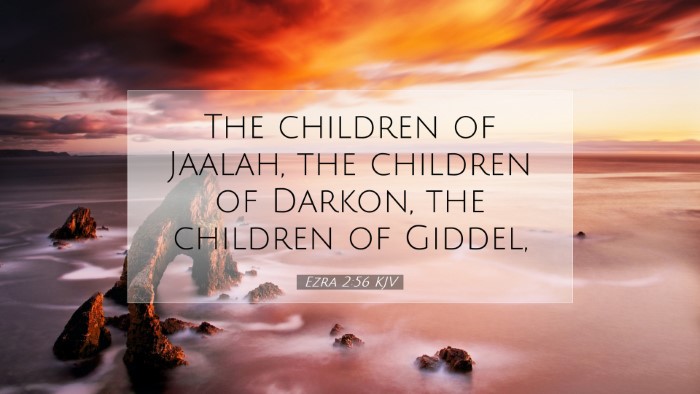Bible Commentary on Ezra 2:56
Ezra 2:56 provides a brief yet significant insight into the people who returned to Jerusalem. This verse is a part of a larger narrative that focuses on the restoration of the Jewish community after the Babylonian exile. The mention of specific groups within this number highlights the diversity and the communal aspects of those returning to their homeland.
Contextual Overview
The book of Ezra is primarily concerned with the return of the Jews from Babylonian captivity and the rebuilding of the Temple. This chapter lists the individuals and families that came back, serving as a census of sorts. In verse 56, we encounter the descendants of Solomon’s servants, which holds particular theological and historical significance.
Interpretative Insights
From various public domain commentaries, we can draw several key insights regarding Ezra 2:56.
1. The Role of Solomon’s Servants
According to Matthew Henry, the reference to Solomon’s servants emphasizes the legacy and importance of service in the context of the Jewish community. These were not just any servants but were linked directly to the glory of Solomon’s reign, symbolizing a divine purpose and continuity through the generations.
2. A Testament to Restoration
Albert Barnes notes that the inclusion of these descendants serves as a testament to the restoration of the Jewish people. It signifies the faithfulness of God in preserving even those who were once in a subservient position in the royal household. The return of these families shows that God remembers His promises and fulfills His covenant with His people.
3. Enumeration and Identity
Adam Clarke comments on the importance of enumeration in scripture. It serves to establish a sense of identity and belonging within the community of Israel. The process of recording names and lineages was vital for the re-establishment of a national identity post-exile. This verse thus functions as a bridge connecting the people back to their roots.
Theological Implications
The broader theological implications of Ezra 2:56 are manifold. The passage speaks to several key themes in scripture:
- Covenant Faithfulness: As highlighted by all commentators, God's faithfulness to His covenant stands out. Even in exile, God preserved a remnant, and now those who return signify hope and restoration.
- Community and Heritage: The gathering of Solomon’s servants underlines the importance of community and shared heritage in God's plan. The rebuilding of Jerusalem was not just a physical endeavor but a communal act, integral to the identity of God's people.
- Service and Ministry: The legacy of Solomon's servants also emphasizes the role of servitude in God's kingdom. Those who returned to Jerusalem were called back not just to inhabit the land but to serve in various capacities for the restoration of worship and community.
Practical Applications
For pastors, students, theologians, and Bible scholars, several practical applications can be drawn from Ezra 2:56 and its commentary:
- Teaching on Remnant Theology: The concept of a faithful remnant can inspire sermons on God’s faithfulness amidst adversity. It provides a basis for understanding how God can use even small numbers for His glory.
- Encouragement in Ministry: Just as Solomon’s servants returned to serve, ministry leaders can be encouraged that God calls individuals from all walks of life to serve in His kingdom purposes.
- Lessons in Community Building: The process of re-establishing community after disruption can be mirrored in contemporary church life. Focusing on shared heritage and identity is crucial for fostering unity within congregations.
Conclusion
Ezra 2:56 encapsulates a vital moment in the history of Israel where God’s faithfulness is displayed through the return of key servants associated with Solomon. Each commentator brings to light different aspects of this text, enriching our understanding of its implications for both the original audience and for contemporary believers. This verse stands as a reminder of God’s ability to restore His people and the importance of community, identity, and service in His redemptive work.


